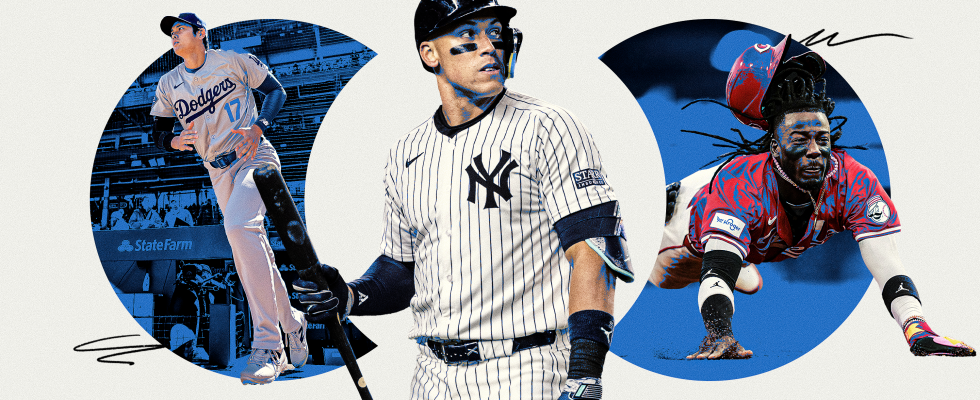So what do you know. We made it through April. What a bizarre month.
Taylor Ward outhomered a guy who hit 54 homers last year (Matt Olson). Maikel Garcia had more extra-base hits than Vlad Guerrero Jr.
Ronel Blanco has been the best starting pitcher on the Astros. The reigning National League Cy Young Award winner (Blake Snell) has been the worst starting pitcher on the Giants.
Josh Hader’s ERA is over 6.00. Brennan Bernardino’s ERA is under 1.00.
Why do we even pay attention to this stuff?
You think LeBron James has ever had 25 games like Aaron Judge’s first 25 games (.191/.319/.383 slash line)? It’s not even possible — not in that sport. But baseball — well, it’s not that sport.
“It’s just a different sport,” one American League executive was saying the other day. “But that’s why I love our game — because it’s so unpredictable.”
Yeah, it can be a wacky ride on the Tilt-A-Whirl, all right. So it can be difficult to know what to make of baseball in April. But hey, it’s your lucky day. We’re here to help you make sense of it — with your favorite column and ours: What We Learned in April.
1. Baseball is hard
Paul Goldschmidt, just two years removed from an MVP season, is one of the many big-name players off to poor starts. (Rick Scuteri / USA Today)
We shouldn’t need a reminder of this. But baseball is hard.
Ask Aaron Judge (see above). Ask Paul Goldschmidt (four extra-base hits in April). Ask Julio Rodríguez (three extra-base hits all month). Ask Corbin Carroll (slugging .246 this season). Ask Alex Bregman (hitting .216, with no homers until his last game of the month).
But not just them. Ask some of the biggest shooting-star prospects in baseball.
“I think of other names,” said another exec, who spends a lot of time on scouting and player development. “Like Jackson Holliday (just sent down by the Orioles after going 2-for-34). Like Darell Hernaiz (who’s at .174/.264/.174 for the A’s). Like Victor Scott II (who was 5-for-59 for the Cardinals before being demoted). Look at those three. Look at what they’ve done. They’ve hit worse than pitchers.”
There are many more names, of course. Just remember those names are guys who have been great at baseball all their lives. But this April, they haven’t been that great. And mostly, it all comes down to this:
Baseball is hard. Harder than ever. As velocities creep up. As pitch shapes are scientifically designed in the lab to devour bats. As AI-generated data says: Throw it there, and this dude can’t hit it.
“You know, it’s so rare that the best players play their best for 162 games in 186 days — from day one,” said one of the execs quoted above. “That’s just not how it works.”
But why should that stop us from overreacting when we look at stars hitting .177 on April 29? Overreacting to April is a beautiful baseball tradition. So don’t make us stop. It’s what we do best. But when you hear us do that, feel free to hit us with those three magic words: Baseball is hard. It’s true!
2. Current state of the Astros’ dynasty: Rickety
The Houston Astros have 10 wins all season. They used to think nine wins was a disappointing postseason. But here they are, 10-19 after 29 games. So they’re officially in the danger zone. Not just this year, but as they return to Earth’s orbit in the seasons beyond this year.
Before they journeyed to Mexico last weekend and bludgeoned the cliff-diving Rockies twice, the Astros were just 7-19. Did you know only one team in history has started a season 7-19 or worse and made it to the postseason? And that team — the 1914 “Miracle” Braves — pulled off that fabled miracle 110 years ago.
So the canyon these Astros have dug for themselves is deep — so deep that both the history and the math say they’re a really bad bet to recover.
Here’s the history: Forget the 7-19 part. You can even forget all the years before the wild-card era (1995-present). In this era, since 1995, only three teams have been 12 games under at any point in the season and survived to play baseball in October. Just one team — the 2005 Astros — has done that after falling more than 12 games under.
Now here’s the math: The AL’s lowest wild-card seed last year won 89 games. To get to 89 wins, the Astros would have to go 79-54 from here. So they would have to play like a 96-win team the rest of the way. Which means, said one exec, “that even if they play like a 90-win team, they’ll win 84 games. So it’s a huge hole. It’s a massive hole.”
Yet another exec we spoke with said, matter-of-factly: “I’m not a betting man, but if I were betting a buck, I’d bet they’ll make the playoffs — still.”
Wait. What about what history tells us about teams that start the way these Astros started? “Those teams didn’t have the projections or the expectations that this team has,” he said. Plus six games out in the division, with 133 to play, doesn’t seem out of the reach of a roster like this, he added.
Maybe he’s right. Maybe that hole isn’t as massive as it looks. But what if it is? That possibility has rival front offices already wondering what a trade deadline Astros sell-off might look like.
They have no trouble imagining Justin Verlander, Alex Bregman and Ryan Pressly (all prospective 2024 free agents) getting dealt. But what about Kyle Tucker and Framber Valdez — both free agents after 2025?
It’s a fascinating topic … except for one thing. Remember owner Jim Crane’s etched-in-stone quote after extending Jose Altuve a couple of months ago: “While I’m here, the window (to win) will never close.”
We reminded the execs we polled of Crane’s words. They pointed at his team’s declining farm system and already hefty payroll. So can the Astros keep that window open indefinitely? Really?
“Good luck with that,” one AL exec said.

GO DEEPER
What’s next for José Abreu and the Astros after option agreement?
3. Spring training is underrated
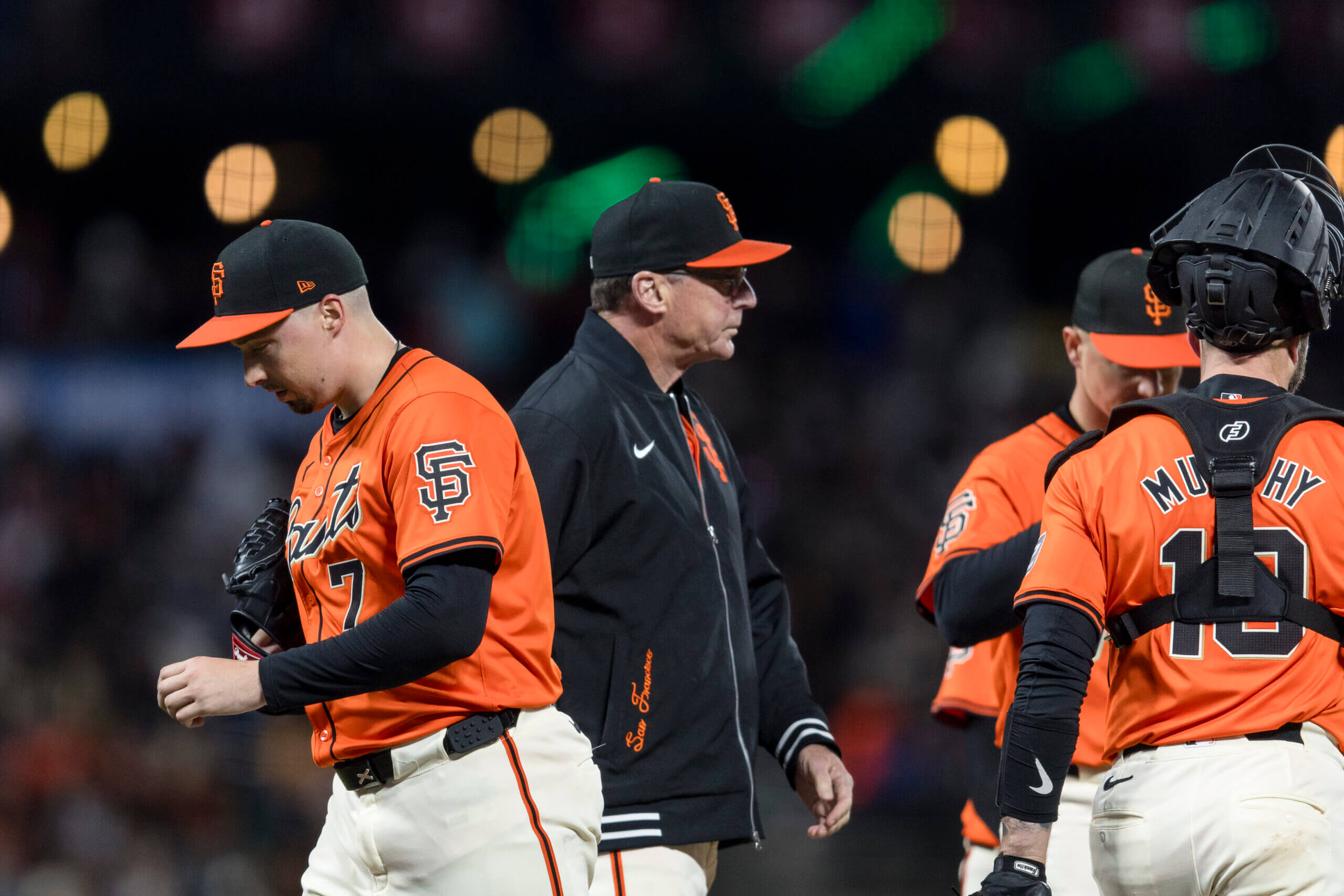
Blake Snell exits his third start for the Giants after allowing five runs in 4 2/3 innings. (John Hefti / USA Today)
Let’s check in on “the Boras Five.” That would be Blake Snell, Matt Chapman, Cody Bellinger, Jordan Montgomery and J.D. Martinez — the five prominent Scott Boras clients who waited out the market all winter and didn’t find a team until March.
Snell: 0-3, 11.57 ERA after three starts, just went on the injured list with an adductor strain
Chapman: .222/.266/.385, similar to his numbers from May of last year
Bellinger: .226/.320/.440, just went on the IL with fractured ribs
Montgomery: 1-1, 2.70 after two starts, even beat Snell in one of those
Martinez: Injured his back during extended spring training, only debuted Friday
Those five will collect a combined $101.37 million this season. There’s plenty of time for their play to match that money. But first, this word from our imaginary sponsors:
Spring training is more meaningful than it sometimes appears.
Just ask the guys who miss it — and the front-office minds who roll the dice and sign those guys anyway.
“How many times,” mused an NL exec, “have we seen guys try to hold out, then sign late, and the agent the whole time is saying ‘Oh, he’s fine. I’ve got him throwing.’ And it’s not the same. I don’t know what the percentage is, but I bet it’s high, that somewhere early in the season, it bites them, and they end up being injured and missing more time. Then you kick yourself as a GM, going: ‘I knew better than this.’”
Well, it turns out MLB Network’s Research Department has looked into that. They furnished us with a list of notable recent free agents who didn’t sign until March. Then we looked at how April went for the biggest names on that list.
The Pitchers
| PITCHER | DATE SIGNED | APRIL |
|---|---|---|
|
Lance Lynn, 2018 |
March 12 |
0-3, 8.37 ERA |
|
Jake Arrieta, 2018 |
March 12 |
3-1, 3.49 ERA |
|
Greg Holland, 2018 |
March 31 |
0-1, 7.36 ERA, 0 saves |
The Hitters
| HITTER | DATE SIGNED | APRIL |
|---|---|---|
|
Carlos Correa, 2022 |
March 22 |
.243/.309/.324, 1 HR |
|
Trevor Story, 2022 |
March 23 |
.224/.292/.299, 0 HR |
|
Nick Castellanos, 2022 |
March 23 |
.300/.374/.475, 3 HR |
A few words about that group:
A) Not much good came out of the 2022 lockout, but at least it gave us a handy database of free agents who signed really late.
B) none of those three pitchers went on to have the kind of season they were signed to have — but especially Holland, who had led the NL in saves the year before. In his very first outing for the Cardinals, nine days after signing, he walked four in one-third of an inning and walked in the winning run. Four months, 32 outings and a 7.92 ERA later, he was released. So that went well!
Look, this is a small sample. We don’t know how it will apply to the Boras Five. But is spring training really meaningless? Not if you’re a free agent, said one exec we surveyed.
“The routine, the process of getting ready for a major-league season, can’t just happen in two weeks,” he said. “It’s everything. It’s the preparation on the field. It’s getting settled with new surroundings and new environments, new coaches, new teammates. It’s getting an apartment or a place to live.
“There’s a lot of things you have to handle when you sign late. And baseball is just one of those things.”
4. But here’s the good news for Scott Boras: Juan Soto

Will Juan Soto land a $500 million deal this winter? Things are looking up. (Wendell Cruz / USA Today)
In last year’s first edition of the What We Learned column, we made this regrettable pronouncement: Juan Soto should have taken the Nationals’ money!
Ehhhh, have we mentioned that overreacting to April is one of those things we’re best at?
Juan Soto, San Diego Padre, didn’t have the look of a generational talent. But Juan Soto, New York Yankee? That guy might have a future.
In his first 30 games in The Pinstripes, Soto bombed seven homers and reached base 60 times. Look at all the players in history who have done that in their first 30 games as a Yankee:
Juan Soto, 2024
(don’t go looking for the other names … he’s it!)
“What happened in San Diego did not surprise me,” said one exec who has known Soto for years, “because I think it shocked the hell out of him that the team that signed him, groomed him and developed him was the same team that traded him. And then the reality of that hit him. And he was on the other side of the country, as far away as he could be from the Dominican (Republic). So I wasn’t surprised. I really wasn’t.”
But now here’s Soto, in the Bronx, leading the Yankees in average, on-base percentage, slugging, OPS, homers, RBIs and runs scored. And most of the execs we surveyed now think he’s a lock to sign a deal when he reaches free agency this winter that tops the $440 million the Nationals offered him in 2022. We should mention, though, that opinion wasn’t unanimous.
One exec mentioned the piece Brittany Ghiroli wrote in The Athletic about Soto’s adjustment issues in San Diego — and said that would “scare the absolute crap out of me” if his team was thinking about dangling half a billion dollars in front of Soto.
The Yankees, obviously, wouldn’t have to worry about that unknown. But if this turns into a negotiation involving only a couple of teams, “how big is it going to get?” the same exec asked. “I question if (the contract) is going to start with a five at that point.”
Whether it will or it won’t is a mystery to be solved many months from now. But either way, you won’t have to worry about whether Juan Soto will be able to afford that brand new 4K Ultra HD flat screen for his basement.
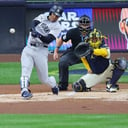
GO DEEPER
Three takeaways from Juan Soto’s first month with the Yankees: ‘Once-in-a-generation’
5. Ohtani’s latest trick: Leading the league in tunnel vision

The spotlight on the start of his Dodgers career hasn’t appeared to faze Shohei Ohtani. (Geoff Burke / USA Today)
We already knew that Shohei Ohtani was Superman. But it turns out we were selling him short. What he really is, is Superhuman.
That’s a gig that doesn’t come with a cape, a side gig as a geeky newspaper guy or a date with Lois Lane. But it’s just the latest reason to look at Shohei the Magnificent and ask: “What can’t he do?”
Entering Tuesday, more than a month into his first season as a Dodger, Ohtani had a 189 OPS+. That would be a career best even for him.
He fired off an amazing 22 extra-base hits in his first 30 games, putting him on pace for a ridiculous, Ruthian total of 119.
And those 22 extra-base hits in 30 games? That’s tied for the second most by any player in the modern era who had just changed teams — and the most since Hack Wilson joined the Cubs … 98 years ago.
On one hand, Ohtani hasn’t mixed in any 14-strikeout games on the mound, due to ligament issues that are currently under repair. On the other hand, he’s had kind of an eventful month off the field.
This is not the place for a recap of the life and times of Ippei Mizuhara. But imagine how you’d perform in your job if you woke up and found out the person you spent countless hours a day with was under multiple federal investigations … and ohbytheway, you would never see him again.
This is, basically, the Tunnel Vision Olympiad. And as Shohei is busy scarfing up gold medals in that competition, the execs in our survey were in disbelief at how he’s been able to do what he does.
“I don’t know why it’s not a bigger story on Planet Earth what this guy is doing,” one exec said.
“It’s incredible,” another said. “He moved to a new environment and a new team. He had about as big a distraction as you could possibly have. And he seems unaffected by it. His ability to focus and just be incredible is one of a kind. It’s unique. Nobody can do what he does.”
6. The word for Bobby Witt Jr. and Elly De La Cruz: Superstars
There comes that moment in the life of every great player when the rest of civilization comes to realize what he is. For Bobby Witt Jr. and Elly De La Cruz, that moment felt like it arrived last month.
Unless you live in the 816 area code, you might think there’s no reason to stop what you’re doing when Royals highlights flip across the screen. OK, here’s a reason to reevaluate that thought.
Bobby Witt Jr., you are ridiculous 🤯
(via @MLB)
pic.twitter.com/cFLdmpOXJA— FOX Sports: MLB (@MLBONFOX) April 28, 2024
Bobby Witt Jr., friends. He’s a force of nature.
Sprint speed: 30.3 feet/second, 1st among full-time players
Hard-hit rate: 59 percent, 5th in MLB
Defensive Runs Saved: 6, 1st among MLB shortstops
Arm strength: 90.1 mph, 3rd among MLB shortstops
“’I’ll tell you what he’s done, in my opinion,” said an NL exec. “By having him step up to become that superstar, what he’s done is cause Salvy Perez to step up his game and get back to being the player that he has been.”
Excellent point. That’s what superstars do. They elevate everyone around them. Speaking of which … Elly De La Cruz. We’re starting to get the impression he’s good at doing things other humans can’t do.
Elly De La Cruz threw this ball 106.9 miles per hour 😯 pic.twitter.com/JgddfUlFuW
— Baseball Quotes (@BaseballQuotes1) April 30, 2024
Let’s summarize Elly’s month for the Reds: Switch hit inside-the-park and outside-the-park homers in the same game. … Stole home. … Hit three home runs that sailed a projected 443 feet or farther. … Stole three bases in a game twice. … Hit as many home runs (eight) as Pete Alonso. … Even was alleged to have thrown a baseball at an unheard of 106.9 miles per hour, except (very unfortunately) Statcast later told us that, well, no he didn’t.
But hang on. There’s more. The Reds started playing baseball four years after the Civil War. Records are a little sketchy from that era. But over the past 110 seasons, only one Red — Eric Davis — had ever had any calendar month in which he stole at least 17 bases and hit more than one home run.
Elly De La Cruz just stole 17 bases and hit eight homers in the first full calendar month of this season (and stole 18 altogether, counting March). Why do we think there might be more months like that in his future?
“The tools are insane,” said one exec. “But the improvements that he’s made are the type of improvements that superstars make when they’re young. His ability, his approach at the plate, the things that he does, at-bat to at-bat and game-to-game, show you that he is going to be an absolute (laughs) — ‘superstar’ doesn’t even capture it, more like a unique generational talent.”
Superstar doesn’t even capture it. Whoa. No wonder he showed up in this column.
7. The White Sox, Rockies and Marlins are on ’62 Mets Watch
Let the record show that 62 years ago, on their way to becoming the losingest team of modern times, Casey Stengel’s 1962 Mets (final record: 40-120) won 11 of their first 30 games. Do the 2024 White Sox, Rockies and Marlins even want to know that? Let’s go with no.
As they flipped their calendars to May, the White Sox were 6-24. The Rockies were 7-22. The Marlins were 7-24. So they’re already a combined 50 games under .500!
They’ve been outscored by a total of 213 runs. They’ve ripped off losing streaks of nine, seven, seven, six, six and five games. Their starting pitchers are a combined 10-43. Their relievers have teamed up for eight more blown saves (19) than saves (11).
So is it nuts to say they’re making Casey’s Mets look like the Big Red Machine?
The Rockies have played 29 games — and trailed at some point in every one of them. That broke a record set by Farmer Ray’s 1910 St. Louis Browns, who fell behind in each of their first 28 games of the season … on the way to losing 107 times. Let’s blame Coors Field!
The Marlins made the playoffs last year. They rode that wave this year by losing more games before May 1 (24) than any team in National League history. They’re 3-15 at home. They didn’t lose their 15th home game last year until June 20. Good times.
The White Sox went into Tuesday night with 79 runs scored all season. The Dodgers scored their 79th run on April 9. The White Sox also got shut out at some point in every one of their first eight series of the season. Want to guess how many other teams have ever done that? None would be a shrewd guess.
So that’s quite a start. Is there a 120-loss season in there someplace? How could we rule that out?
“Before I saw the White Sox, I didn’t see how it was possible to lose 120 games,” said one AL exec. “Now I’m not so sure.”
“But at least the White Sox just started a rebuild,” said another AL exec. “They arguably should have started it a couple of years ago, but whatever. And their best player (Luis Robert Jr.) is hurt. And they just traded Dylan Cease. So you can say they’re on a path to something. But when you look at the Rockies’ roster … (big pause)
“I just find it shocking,” he continued, “that they’re in a division with the Dodgers, the Giants, the Padres and the Diamondbacks. And they are nowhere close to even being the fourth best team in that division.”
Oh, and one more thing: It’s a bad time to tank! The White Sox and Rockies both have top-six draft picks this year … which means they can’t pick higher than 10th next year, thanks to the new anti-tanking rules in the 2022 collective bargaining agreement. So as bad as this season looks for both of those teams, it’s hard to fathom it’s even worse than you think!
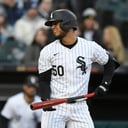
GO DEEPER
Weird & Wild: Could the White Sox lose more than the ’62 Mets? They’re off to a great start!
8. Mason Miller and Jared Jones are a show
You know that section we rolled out earlier about Bobby Witt Jr. and Elly De La Cruz? This is the pitching version.
Mason Miller just finished his first month as the A’s closer. Wow.
Jared Jones just finished his first month as a starting pitcher for the Pirates. Unbe-freaking-lievable.
They’re the answer to this assignment: Pick two young pitchers to watch in a sport full of rocket launchers. Except they have to be two you’d never spent 30 seconds thinking about before this April, pitching for teams that never make it on national TV’s radar.
We’ll accept nominations for Tarik Skubal or Cole Ragans or Nick Lodolo. But it’s our column. And our nomination is these two guys.
Mason Miller has already thrown 86 pitches at 100 mph or harder this year. Only one pitcher in baseball (Michael Kopech, 53) is even within 50 of him. Can it actually be possible that this dude has hit 100-plus on more than 43 percent of the pitches he’s thrown this season? It is, all right. Nobody else is even at 20 percent.
He has struck out 15 hitters on fastballs this year … and all 15 of them were on pitches that splattered triple digits all over the radar board. Five of those strikeouts came in his two saves at Yankee Stadium last month. The Statcast readings on those five pitches: 103.3, 102.5, 102.5, 101.9, 101.3. That happened … in real life.
Absolute GAS from Mason Miller against the top of the Yankees’ order to secure the save ⛽️🔥
🎥: @PitchingNinja pic.twitter.com/AiCZVTuGMa
— FOX Sports: MLB (@MLBONFOX) April 22, 2024
Jared Jones, meanwhile, has piled up 105 swings-and-misses in the first six starts of his career. Seriously? That’s the most swings-and-misses by any pitcher in the majors — and nearly all of the pitchers who are even within 20 whiffs of him are guys who have thrown at least 100 more pitches than he has.
He’s averaging 17.5 whiffs per start, even though he only works long enough to serve up 81 pitches a start. Gerrit Cole averaged 9.2 whiffs per start in his first season as a Pirate — and has only hit 17.5 in one season over his career (2019). So … get the picture? We have a true dominator on our hands.
Jared Jones just KILLED a man. 🤣 pic.twitter.com/rcdh9KbbSK
— Rob Friedman (@PitchingNinja) April 22, 2024
But we’re not the only ones gushing. Want to hear actual baseball executives gush right along with us?
“Mason Miller — oh my God,” said one exec. “He could throw a marshmallow through a battleship.”
“The biggest story on the Pirates is the Jared Jones extravaganza every five or six days,” said another exec. “He’s awesome. And when they bring up (Paul) Skenes and they have both of those two guys, you’ll be going, ‘Oh (bleep), we’ve got both these guys on tap in this series?’ That’s going to be scary for a lot of teams.”

GO DEEPER
How a diabetes diagnosis turned around A’s closer Mason Miller’s career
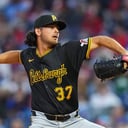
GO DEEPER
‘Sliders’: How the Pirates are managing young arms, a Leiter family milestone and more
9. Baseball is winning the war on dead time
Yeah, yeah. We know The New Rules were last year’s story, not this year’s story. But that doesn’t mean there’s not stuff going on in Year Two. So here goes.
We’ll let other people debate whether the pitch clock causes injuries. We were curious about the impact of the two seconds MLB shaved off that clock with runners on base this season (from 20 seconds to 18). It’s all part of the war on dead time. And the data is clear. Dead time is losing that war.
AVERAGE TIME BETWEEN BALLS IN PLAY
2022: 3 minutes, 42 seconds
2023: 3 minutes, 13 seconds
2024: 3 minutes, 10 seconds
AVERAGE TIME BETWEEN PLATE APPEARANCES
2022: 2 minutes, 29 seconds
2023: 2 minutes, 8 seconds
2024: 2 minutes, 6 seconds
AVERAGE TIME, 9-INNING GAME
2021: 3 hours, 10 minutes
2022: 3 hours, 3 minutes
2023: 2 hours, 39 minutes
2024: 2 hours, 36 minutes
GAMES OF 3:30 OR LONGER*
2022: 28
2023: 3
2024: 1
(*before May 1, not including extra innings)
(Source: Baseball Reference)
MLB’s public goal was to trim five minutes off the average game time, which crept upward as last season wore on. That hasn’t quite happened. But the average time between balls in play is down to its lowest level since 2008. And the average time between plate appearances is now tighter than in any season in at least the last 25 years.
So we can argue about how many seconds to set the clock at, or the long-term impact on player health. But baseball is a rhythm sport. And if the pitch clock has done anything, it has restored the rhythm to a game that thrives on that rhythm.
As one AL exec put it, “the game is so much better now than it was 36 months ago. … Better tempo. More attractive to watch and to play. I don’t even think we’ve played a three-hour game yet. And that is awesome — for our fans and for our players.”

GO DEEPER
Guide to Year 2 of MLB’s new rules: The ‘cat-and-mouse’ game is on as the sport evolves
10. The biggest surprises: The Guardians, Royals … and Cardinals?

Salvador Perez, Bobby Witt Jr. and company have the Royals rolling. (Melissa Tamez / USA Today)
You’d have a better chance predicting the Powerball numbers tonight than you would predicting the outcome of any baseball season. That was true in 1924. It’s just as true in 2024. There is always something we didn’t see coming.
But before we go further in this discussion, let’s address that thing we know some of you are thinking: We haven’t talked about the Braves or Orioles … or the Cubs or Phillies … or those defending World Series champs, the Rangers. We haven’t gotten to Mookie Betts or Gunnar Henderson or Josh Naylor … or Ranger Suárez or Shota Imanaga.
Right! If that’s what you’re thinking, we hear you. We get it. We’re sorry. We hate to disappoint you. But the What We Learned column wasn’t invented to be a recap of the month that was. It was invented to be a deep dive into lessons that month has taught us.
It isn’t every lesson. It may not be the same lessons you learned. It’s just stuff we found interesting — and that the front-office minds we surveyed found interesting. So with that out of the way …
We asked these execs to give us their biggest surprises so far. Here are the teams they named most.
THE GUARDIANS — In the first 25 games of his managerial career, Stephen Vogt’s Guardians went an amazing 18-7. We could only find two other managers in the wild-card era who went 18-7 or better — starting with Opening Day — to kick off their first big-league managerial gig: Alex Cora (19-6 with the 2018 Red Sox) and (speaking of surprises) Grady Little (18-7 with the 2002 Red Sox).
“For me, that’s one of the biggest surprises of the first month,” one exec said of Vogt and the Guardians. “I can’t get over how well they have responded. Because he’s replacing a guy, in (Terry Francona), who was the best players’ manager going. And now this guy comes in and, at least on the surface, looks to be the same kind of guy. They’ve responded. And, in a way, it almost looks like they’ve been reenergized.”
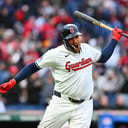
GO DEEPER
Polaroids, bat slams and ‘saying the stupidest thing’: Inside the Guardians’ scorching start
THE ROYALS — The 2023 Royals lost 106 games. That’s not usually the prelude to a trip to October. But if the 2024 postseason started today, the Royals would be playing in it. And that’s a testament not just to all the money they spent on pitching upgrades last winter but also to the most surprising offense in baseball. Who had the Royals outscoring the Astros?
“The Royals I think are the biggest true surprise,” said one rival exec. “They are pitching unbelievably. I think they’re third or fourth in the (American) League in (FanGraphs) WAR, which is really shocking to me. And that’s on top of the way they’re playing offensively, which is also shocking to me. We thought they were improved — like sniffing .500 improved — but not like this. … Is it going to last all season? I don’t know. But it’s cool for a town that loves baseball.”
THE CARDINALS — We never said all these surprises had to be good surprises. So sure, this qualifies. To see the Cardinals in last place … and last in their league in homers … and 28th in baseball in runs scored … with a pitching staff that has barely been league average (with a 108 ERA+) … it’s out of whack with all the preseason predictions that had them rebounding to win their division.
True, they finished last in the NL Central a year ago, too. But the last time the Cardinals finished last two years in a row was kind of a while ago — as in 1907 and 1908.
“It’s not so much you’re surprised they’re in last place,” said one exec. “It’s more surprising that they actually look like a last-place team.”
Is that what we expected? But just like all of this, it’s what we learned in a fascinating first month.
(Top image: Sean Reilly / The Athletic. Photos: Aaron Judge: Dustin Satloff / Getty Images; Shohei Ohtani: Michael Reaves / Getty Images; Elly De La Cruz: Dylan Buell / Getty Images)

